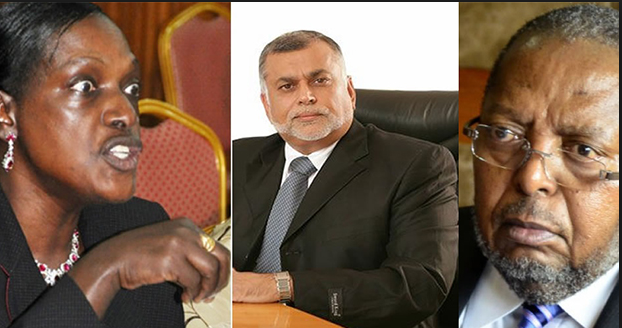The fight with Bank of Uganda Governer Emmanuel Tumusiime Mutebile has lifted the lid off his no sacked Executive Director of supervision Justine Bagyenda’s alleged role in the controversial Crane Bank transaction. Documents that Bagyenda previously kept under lock and key have leaked raising questions over the deal and sparking off fresh suits.
Key amongst these documents is the purchase of assets and assumption of liabilities agreement entered between BoU and DFCU Ltd on January 2015 last year.
The agreement, which The Independent has obtained, had remained a top secret. Not even the former shareholders of Crane Bank had been able to access it.
Sudhir’s lawyers say they are shocked that the agreement states neither what DFCU bought when it took over Crane Bank or the price it paid and on what terms.
What kind of agreement doesn’t state a purchase price? How can an agreement not state payment terms? These are questions Sudhir’s lawyers as in a document titled “Major Contentious Issues with the purchase of Assets and Liabilities Agreement Entered into between Bank of Uganda and DFCU Bank Limited”.
They point out that neither the liabilities, nor the assets taken over by DFCU, the net purchase price and the payment terms for monies DFCU was supposed to pay to BOU are stated.
Of the assets owned by Crane Bank, the agreement only lists the 53 Crane Bank branches. Yet at the time it was taken over, Crane Bank’s total assets were worth Shs.1.3 trillion.
Even for the branches, Sudhir’s Meera Investments Limited, which owned them and had leased the same to Crane Bank, had valued these assets at Shs100 billion but BoU whittled down the value to a paltry Shs 10 billion. Yet when DFCU acquired them, it automatically valued them at Shs 47 billion – making a clean profit of Shs 37 billion by the stroke of a pen.
Sudhir’s lawyers base on these revelations to conclude that the terms of the agreement were agreed fraudulently and secretly in documents outside the main sale agreement.
“The net result of these fraudulent side deals was that DFCU got a bank with 1.3 trillion of Assets for a net payment of just 200 billion (payable under side deals over a period of about 3 years),” reads a memo prepared by Sudhir’s lawyers, “all of this was to the detriment of the shareholders and other legitimate creditors and for the benefit of DFCU and the BOU officials and their transaction advisors.”
As a result of this deal, within just three months of taking over the assets of Crane Bank, DFCU reported a growth in its profits from those of the previous year from Shs.31 billion to over Shs.150 billion. At the time, other banks were reporting poor performance.
Compromised lawyers, bad loans
“The lawyers who structured the sale transaction appear to have been compromised and working for both parties secretly,” reads a memo prepared by Sudhir’s lawyers, “They represented BOU and connived with some BOU officials to give DFCU a sweetheart deal and then they immediately crossed over and went to work for DFCU to collect money and fees on the same assets they had just transferred to DFCU.”
Immediately after concluding the sale of Crane Bank to DFCU as Bank of Uganda lawyers, Sudhir’s lawyers claim both MMAKS Advocates and AF MPANGA (BOWMANS) switched sides to work for DFCU to collect loans and earn fees from the same Crane Bank loans they claimed were written off and uncollectable. To this day, the two law firms, Sudhir’s lawyers say, continue to work for DFCU to collect Crane Bank money.
While Mpanga’s Bowmans conducted a review on the non-performing portfolio for DFCU, court documents indicate that MMAKS is handling some 49 cases on former Crane Bank assets on behalf of DFCU.
Sudhir’s lawyers claim that Bagyenda gave DFCU permission to secretly account for these bad loans on a secret basis outside the official books of DFCU Bank.
Sudhir’s lawyers claim the money DFCU is collecting from these loans belong to him and other former shareholders of Crane Bank.
Sudhir’s lawyers say up to Shs600 billion worth of Crane Bank loans (assets) were listed as Non-Performing Loans and removed from Crane Bank’s balance sheet at time of BoU takeover.
Using its fiduciary rules, BOU had made the shareholders of Crane Bank, mainly Sudhir, to pay for these loans out of their share capital to the tune of Shs 350 billion.
An additional amount of US$ 23.5 (Shs85 billion) in three additional shareholder payments (US$ 8M, US$ 7.5M and US$ 8M), was also paid to BoU by Crane Bank shareholders. That, according to Sudhir’s lawyers, means that it is Sudhir who should receive any money that debtors pay and not DFCU.
Instead, BoU officials, Sudhir’s lawyers argue, secretly entered into a side accounting arrangement with DFCU bank to collect from these loans and secretly account for and share proceeds of these collections amongst DFCU and BOU officials.
Seen are documents showing that between December 2017 and Feb.1, DFCU has collected Shs 52 billion from the so-called bad loans.
Also seen a report prepared by Mpanga’sBowmans of the same as non-performing loans. The report details the status of some 197 properties. The Independent has also seen a list of hundreds of loans that had been written off but continue to be serviced.
It is alleged that the lawyers and some Bank officials pushed the central bank into making mistakes for self-enrichment.The Independent has learnt that privately, Mutebile and many in the bank feel that that Bagyenda visited all current problems on the bank.










